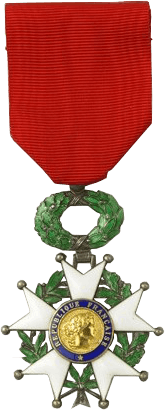Service flag

A service flag or service banner is a banner that family members of those serving in the United States Armed Forces can display. The flag or banner is officially defined as a white field with a red border, with a blue star for each family member serving in the Armed Forces of the United States during any period of war or hostilities in which the Armed Forces of the United States are engaged. A gold star (with a blue edge) represents a family member that died during service, regardless of cause of death. The deceased might have been killed in action, or died due to unrelated causes.[1]
Based on the star symbols used on the service flag, the term "Blue Star" has come into use in the United States as a reference to having a family member in active military service, and the term "Gold Star" has come to refer to the loss of a family member in military service. For example, the mother of a person who died in service is referred to as a "Gold Star mother", and the wife of an active service member is referred to as a "Blue Star wife". Charitable support organizations have been established for Gold Star mothers, Gold Star wives, Blue Star mothers, and Blue Star wives. The last Sunday in September is observed as Gold Star Mother's Day, Gold Star family members are entitled to wear a Gold Star Lapel Button, and all 50 U.S. states and Guam offer some form of a specialty license plate for motor vehicles owned by Gold Star family members.
The use of the terms has sometimes been restricted to refer to service during specific armed conflicts. For example, the service banner originally applied only to World War I, and it was later expanded to include service in World War II, then the Korean War, then other specific conflicts, and then "any period of war or hostilities". In some current uses of the "star" terminology, there is no longer any distinction made about the place or time or degree of hostility involved in the military service.[2] For Gold Stars, the Department of Defense also makes a distinction about the manner and place of death, but some other organizations do not.[3] The Gold Star term is also sometimes interpreted to apply to those missing in action and those who did not die during active service but died later as a result of an in-service injury.[2]
A lesser-known practice of using a silver star to indicate a service member that has been disabled is sometimes also followed, although this practice is not recognized in federal law.
History




The banner was designed in 1917 by United States Army Captain Robert L. Queisser of the Fifth Ohio Infantry, in honor of his two sons who were serving in World War I.[1][4] It was quickly adopted by the public and by government officials. On September 24, 1917, an Ohio congressman read into the Congressional Record:
The mayor of Cleveland, the Chamber of Commerce and the Governor of Ohio have adopted this service flag. The world should know of those who give so much for liberty. The dearest thing in all the world to a father and mother – their children.[4]
Usage
These flags were first used in World War I, with subsequent standardization and codification by the end of World War II.[5] They were not popular during the Vietnam War, but have come back into use.[6] In modern usage, an organization may fly a service flag if one of its members is serving active duty.[7]
Manufacture of these flags is only allowed by specific government license in the territories under American jurisdiction. The same section of the United States Code that limits manufacture of the banner also mentions lapel pins. There is no legal specification of the banner's size, but according to the DoD code,[8] the flag size ratio must be 10:19, the same as the Flag of the United States. When displayed with the national flag, the latter should take the place of honor. If the flags displayed differ in size, the national flag should be larger.
Blue and gold are the only colors specified for use, but silver stars are increasingly in use to represent those discharged from service because of wounds or being invalided home.[9] The Silver Star Families of America is an organization attempting to encourage the U.S. Congress to make the Silver Star Service Banner official for those wounded or injured in a war zone. Forty-nine states, Guam, Saipan, the U.S. Virgin Islands, the Chickasaw Nation and over 2,700 cities and counties have issued proclamations in support of the Silver Star Banner and of Silver Star Service Banner Day on May 1 of every year.[10]
On April 21, 2010, the United States House of Representatives passed House Resolution 855, a stand-alone resolution recognizing the Silver Star Service Banner and making May 1 Silver Star Service Banner Day. One state, Missouri, took steps to make such recognition a state law.[11]
In World War II, the Brazilian Clube Militar (Military Club) and the Casino da Urca adopted the concepts of the American service banner by giving posters to the family members of the Brazilian Expeditionary Force. On these posters the phrase Daqui saiu um Expedicionário was written, which means "From here came an Expeditionary". Although the design differs from the American banners, the mothers of the Brazilian soldiers also received a pin prominently featuring a blue star similar to American pins.[12]
Individuals entitled to display
The individuals entitled to display the service flag are officially defined in 36 U.S.C. § 901 which reads:
A service flag approved by the Secretary of Defense may be displayed in a window of the place of residence of individuals who are members of the immediate family of an individual serving in the Armed Forces of the United States during any period of war or hostilities in which the Armed Forces of the United States are engaged.[13]
The U.S. Code also discusses the wearing of lapel pins.
Gold Star Mother's Day
On the last Sunday in September, Gold Star Mother's Day is observed in the U.S. in honor of Gold Star mothers, as established in Title 36 § 111 of the United States Code.[14] This was originally declared by Senate Joint Resolution 115 of June 23, 1936.[15] In September 2012, Barack Obama issued a presidential proclamation commemorating September 30, 2012, as "Gold Star Mothers' and Families' Day".[15]
Gold Star license plates
All fifty U.S. states and Guam offer some form of a specialty license plate for motor vehicles owned by members of Gold Star families.[16]
See also
- Blue Star Mothers Club
- American Gold Star Mothers
- Gold Star Wives of America
- Gold Star Lapel Button
- Gold Star Families for Peace
- Yellow ribbon
- Service lapel button
References
- 1 2 "Membership Criteria". American Gold Star Mothers official website. Retrieved August 19, 2016.
- ↑ "How to Join". American Gold Star Mothers official website. Retrieved August 19, 2016.
- 1 2 "Blue Star Banner". American Legion. Retrieved August 28, 2016.
- ↑ Nick Artimovich (May 2, 1997). Description at Flags of the World.
- ↑ John M. Simpson (December 30, 2005). Service Flag Graphics.
- ↑ Service Flags.com.
- ↑ Ebbesen, LGEN Samuel B. (September 1996). "DoD 1348.33-M, Manual of Military Decorations and Awards". Assistant Secretary of Defense (Force Management Policy). About.com. pp. 88–92. Retrieved 7 January 2010.
- ↑ Wisconsin Historical Images (2007), World War I "Sons in Service" Flag.
- ↑ Silver Star Families (2007).
- ↑ de Vera, Cory (April 23, 2010). "May 1 named Silver Star Service Banner Day". Springfield News-Leader. Springfield, Missouri: Gannett Company. p. A.11. ISSN 0893-3448. OCLC 44919665. Retrieved 7 March 2011.
In Missouri and in more than 2,700 cities and counties, government officials have declared May 1 as a day to recognize service men and women injured, ill or dying from service in a war zone.
- ↑ http://museuvirtualfeb.blogspot.com/2010/08/lembrancas-para-as-maes-dos-pracinhas.html
- ↑ "Title 36 – Patriotic and National Observances, Ceremonies, and Organizations". United States Government Printing Office. Retrieved 19 August 2016.
- ↑ "36 U.S. Code § 111 – Gold Star Mother's Day". Law.cornell.edu. Retrieved 17 October 2014.
- 1 2 White House, Press Office. "Presidential Proclamation – Gold Star Mothers' and Families' Day, 2012". Retrieved 29 September 2012.
- ↑ "Gold Star Family License Plate Status". www.goldstarmoms.com. American Gold Star Mothers. Retrieved 3 August 2016.
- Multiple authors (multiple dates). Info about the service flag at Flags of the World. A mirror site of nearly the same information.
- John M. Simpson (December 30, 2005). Service Flag Graphics.
- United States Naval Academy (November 20, 1994). The Service Flag of the United States at USFlag.org.
- United States Government (multiple dates). Service Flag and Service Lapel Button fact sheet at a Pentagon web site.
- "For Those Who Carry On: The Service Flag Still Waves and Makers of Novelties Find Many Ways to Display It", Popular Science, February 1919, p. 29
External links
| Wikimedia Commons has media related to Service flag. |
- Blue Stars for Safe Return: Louise Shreffler—an organization providing blue star stickers and related merchandise. Contains limited information about service flags.
- Ohio Historical Society – Blue Star Banner
